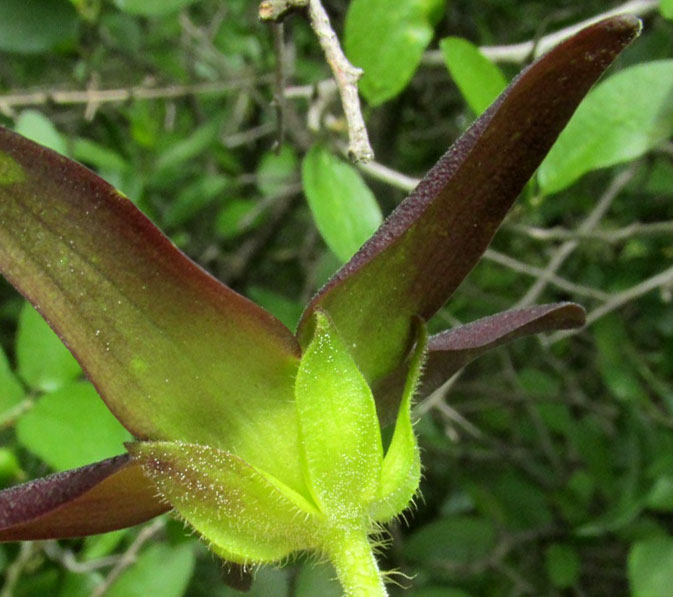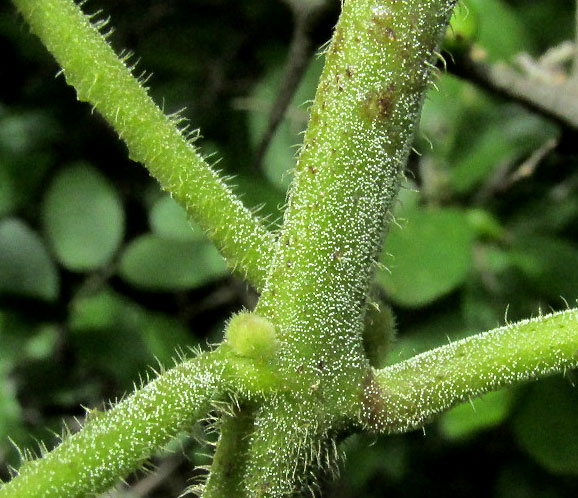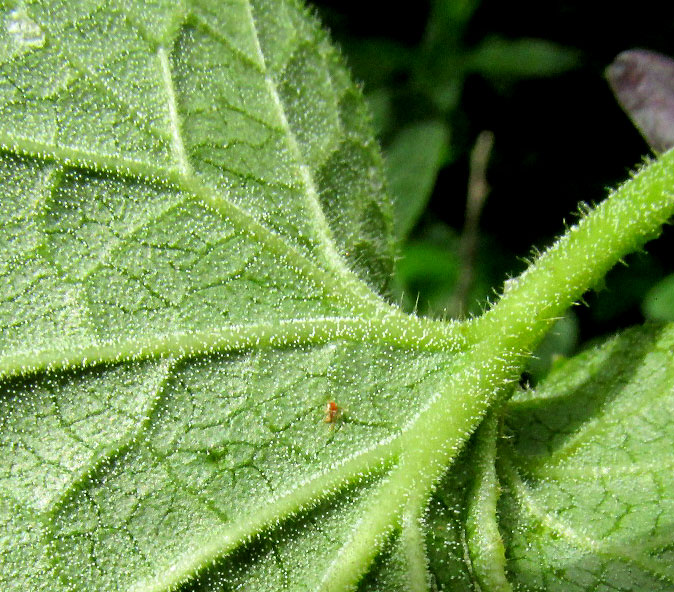Excerpts from Jim Conrad's
Naturalist Newsletter
entry dated September 13, 2022, issued from near Tequisquiapan, elevation about 1,900m (6200 ft), N20.565°, W99.890°, Querétaro state, MÉXICO
POLYSTEMMA PILOSUM

Twining among lower branches of a Desert Hackberry and in some weeds, the above slender vine with heart-shaped leaves and purplish-black, star-shaped flowers seemed to be hiding amid all the clutter. Black flowers like that are unusual, but a glimpse at the blossom's interior finds floral anatomy of a familiar plant family:

It's one of many "climbing milkweeds," members of the Dogbane Family, the Apocynaceae. The signature feature of the family, the gynostegium, is apparent above. The gynostegium consists of highly modified male stamens and female stigmas and styles all fused together to form the curious structure at the center of the above blossom. The somewhat pentagonal, yellowish item at the very center is the stigma head. The tiny, granular, black items at the perimeter of the white ring are heads of stamens' anthers, which are supposed to stick to pollinators as they poke around the area trying to find what smells so good to them. When the pollinator flies to another flower and the stamen's mass of waxy pollen is delivered to another stigma head, pollination will be accomplished.

From behind, as seen above, the corolla lobes are greenish and the sepals yellowish, hairy, and speckled with tiny white dots, presumably glands of some type. Hairs and white dots extend onto the stems and petioles as well:

Leaf bottoms also are soft hairy and white dotted:

The floral anatomy indicates the genus Matelea, whose species go by various English names, none of them specific just to this genus, such as climbing milkweed and milkvine, the "milk" part alluding to white latex that oozes out when a part of the plant is injured.
The Dogbane Family isn't much studied for central Mexico so identification for us comes down to comparing our plant with images on the Internet. Our plant matches best pictures labeled as MATELEA PILOSA*, though a few features of our flower's interior don't seem to match that species exactly Matelea pilosa is endemic just to central and southern Mexico. It bears no English name, though in Spanish it's sometimes called by the evocative Estrella del Zopilote, meaning "Vulture's Star."
Other than the name Matelea pilosa appearing on several lists of species, and a few images of its flowers being posted on the Internet, hardly anything is known about the species' natural history. Even the whole concept of the genus Matelea at this time is shaky. The online depository for pictures of herbarium specimens at the Red de Herbarios del Noroeste de México website tells us that the genus comprises about 250 species and is restricted to warm temperate and tropical regions of the Americas. They say that it's a "little-studied group exhibiting varied and perplexing elaborations of the crown, corolla, and stigma head, and often divided into several dozen segregate genera."
Black and almost-black blossoms are fascinating, seeming to go against the general notions that corollas need to be bright in order to attract pollinators. A recent 2022 publication by Sagheer Ahmed and others, entitled "Why Black Flowers? An Extreme Environment and Molecular Perspective of Black Color Accumulation in the Ornamental and Food Crops," suggests an answer: "The major benefit of black color is the greenhouse effect it generates by absorbing long wavelengths of light, thereby providing warmth inside petals and warm nectar to attract more pollinators during the winter."
But what about black flowers in the tropics? Our high elevation does produce some chilly nights, but most days are agreeably warm and sunny. Remembering certain "carrion flowers" which combine black color and the odor of rotting flesh, -- such as in the closely related genus Stapelia, the gigantic aroid blossom of Amorphophallus titanum, "bat flowers" of the genus Tacca -- one wonders if there's a connection between black flowers and the carrion odor.
Little has been published on Matelea pollination, though Alexander Krings in his 1999 article "Observations on the Pollination Biology and Flowering Phenology of Texan Matelea Regiculata (Engelm. Ex A. Gray) Woods. (Asclepiadaceae)" observed flies visiting a Matelea species.
Maybe rotting flesh is a bit warmer than the environment, because of bacterial activity, so could it be that a black flower's extra warmth is another cue enticing flies looking for carrion?